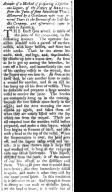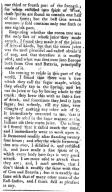[ Account of a Method of Preparing a Spirituous Liquor ]
Date: This is the date range on this weekly publication. | 1769/02/21 to 1769/02/28
Source:
Nova Scotia Chronicle and Weekly Advertiser
Institution: Nova Scotia Archives
| Source Origin: Nova Scotia Newspapers on Microfilm
| Reference: Microfilm Reel 8155
This recipe includes both a spirit made of cocoa juice and one made of maple sap. The writer observed the former in Goa and claims to have invented the latter using the same method, upon observing the use of sugar maple sap in America. Vol. 9, No. 66.
Account of a Method of preparing a Spiritu-
ous Liquor, of the Nature of ARRACK,
from the Juice of some American Trees;
discovered by a Gentleman who was se-
veral Years in the Service of the East-In-
dia Company, and afterwards came to
reside in America.
THE finest Goa arrack is made of
the juice of the cocoa-tree, in the
following manner. The operator fur-
nishes himself with a parcel of earthen
vessels, with large bellies, and short but
wide necks. These he ties about his
waste, neck, and legs, and, thus loaded,
he climbs up into a cocoa tree. As soon
as he is got up among the branches, he
cuts off a knot, and immediately ties one
of his earthen vessels to the wound, that
the liquor may run into it. As soon as he
fixed that, he cuts another knot to make
a wound for another, and so on till he
has hung up all his store of vessels. Then
he descends and prepares a large wooden
vessel to receive the juice. The bottles
are commonly hung on in the evening,
because the tree bleeds more freely in the
night; and the next morning the man
climbs up again, and takes them off
when they are nearly filled with the sap
which ran from the wound. These are
all emptied into the wooden vessel before
prepared, and make a thin liquor, which
soon begins to ferment of itself, and rises
with a head to the top of the vessel. When
the fermentation is over, the head goes
off, and the liquor tastes weak and tar-
tish: It is then thrown into a large still
and worked off, so long as the runnings
taste any think spirituous. This liquor,
distilled from the juice, is of the nature
of our low wines, as the distillers call
them. This is so poor that it would soon
turn sower; but they immediately distill
it again, and make it what they call by
our name proof spirit. In this condition
it is sent over to us: And though it seems
as strong as our malt or molasses spirit,
by the head it bears, it is really but of
one third or fourth part of the strength;
for when rectified into spirit of Wine,
these spirits are found to contain one half
of that spirit; but the best Goa arrack
commonly sold contains only one sixth or
one eight part.
Enquiring whether the cocoa tree was
the only sort of whose juice they made
arrack, I found they made it of the juices
of several kinds, but that the cocoa juice
was the most plentiful and easiest obtain’d
of any, and that therefore it is mostly
used; and what was sent over into Europe
both from Goa and Batavia, principally
made of it.
On coming to reside in this part of the
world, I found that there was a tree
which they call the sugar maple, which
they usually tap in the Spring, and let
out its juices or sap by boring a hole in the
trunk: they brew this with us into a sort
of drink, and sometimes they boil it into
sugar; but nobody, till my time, ever
thought of making any other use of it.
It immediately occurred to men, that it
might be used in the same manner as the
Indians use their cocoa juice. On tasting
it I found that it tasted much the same,
and I immediately went to work upon it.
It fermented readily after standing twenty
four hours; and after the whole fermenta-
tion was over, I distilled it, and rectified
it, and have made a fine spirit of it,
which every body here says is very good
arrack. I am more used to arrack than
they are; and, I must confess, that I
don’t think it exactly the same with that
of Goa and Batavia; but it is exactly the
same with that of many other parts of the
East-Indies, and I think full as pleasant
as any.
Download: Transcription | Images

